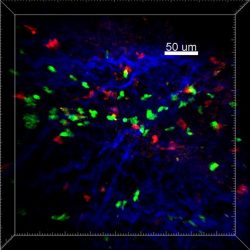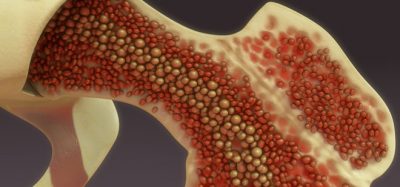Treg cells could be used in immunotherapy to treat multiple sclerosis, study shows
Posted: 22 September 2020 | Victoria Rees (Drug Target Review) | No comments yet
Researchers have discovered how Tregs can reduce spinal cord injury caused by diseases like multiple sclerosis (MS).


In a new study, researchers have discovered how regulatory T cells (Tregs) are instrumental in limiting the damage caused to the spinal cord in diseases like multiple sclerosis (MS). The study was conducted at the University of California, Irvine (UCI), US.


Regulatory T cells (green) shown interacting with pathogenic Th17 cells (red) near collagen fibres (blue) in the spinal cord in a model of multiple sclerosis [credit: UCI School of Medicine].
According to the researchers, the results of the study help explain how Treg cells prevent autoimmunity and dampen immune responses, specifically the negative effects of type 17 helper T cells (Th17) which are known to drive the progression of several autoimmune diseases such as MS.
This new study, which builds on other recent research that identified pathogenic Th17 cells and their role in the progression of several autoimmune diseases, showed how the inhibition of Th17 cells by Treg cells enabled partial recovery from paralysis in a mouse model of neuroinflammation. The team say this finding demonstrates how autoimmune diseases may be effectively targeted using Treg-based cellular therapies.
“We discovered a unique ‘repetitive scanning motility’ by which Treg cells dampen calcium signalling in pathogenic Th17 cells and help to resolve neuroinflammation and limit reactivation of Th17 cells in the spinal cord,” explained Dr Shivashankar Othy, one of the lead authors of the study and a project scientist at UCI.
Senior author Professor Michael Cahalan added: “Building on our years of expertise in immuno-imaging and calcium signalling, this study highlights Th17 and Treg cell interactions, their motility characteristics and intracellular signalling, thus providing new insights into the pathophysiology of MS. Our results illustrate how a regulatory T cell-based immunotherapy may be instrumental in limiting demyelination in MS.”
The results were published in Proceedings of the National Academy of Sciences.
Related topics
Drug Targets, Immunotherapy, Research & Development, T cells, Targets
Related conditions
Multiple Sclerosis (MS)
Related organisations
University of California Irvine (UCI)
Related people
Dr Shivashankar Othy, Professor Michael Cahalan








